1材料概论 材料科学概论课件 双语
- 格式:ppt
- 大小:6.32 MB
- 文档页数:72



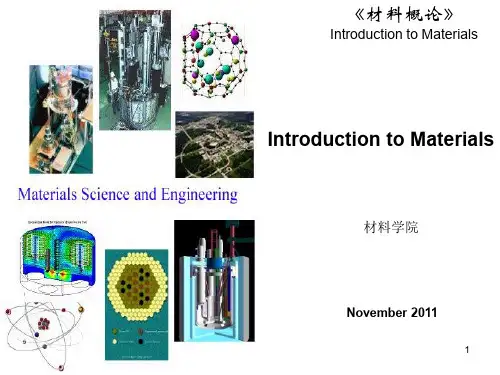
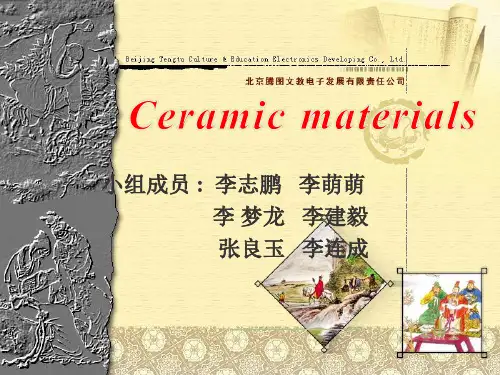
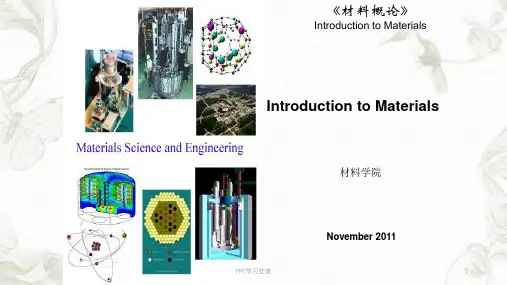
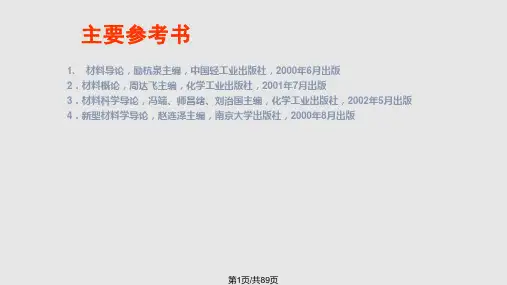
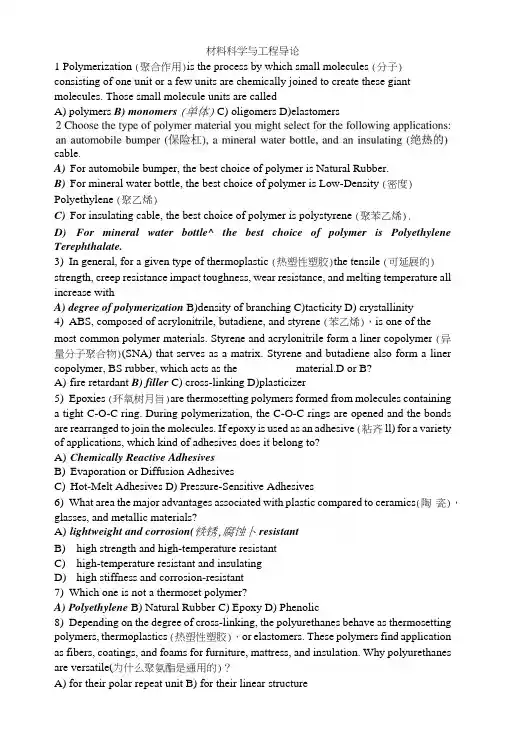
材料科学与工程导论1 Polymerization (聚合作用)is the process by which small molecules (分子) consisting of one unit or a few units are chemically joined to create these giant molecules. Those small molecule units are called _____A) polymers B) monomers (单体) C) oligomers D)elastomerscable.A)For automobile bumper, the best choice of polymer is Natural Rubber.B)For mineral water bottle, the best choice of polymer is Low-Density (密度) Polyethylene (聚乙烯)C)For insulating cable, the best choice of polymer is polystyrene (聚苯乙烯).D)For mineral water bottle^ the best choice of polymer is Polyethylene Terephthalate.3)In general, for a given type of thermoplastic (热塑性塑胶)the tensile (可延展的) strength, creep resistance impact toughness, wear resistance, and melting temperature all increase with _______A) degree of polymerization B)density of branching C)tacticity D) crystallinity4)ABS, composed of acrylonitrile, butadiene, and styrene (苯乙烯),is one of the most common polymer materials. Styrene and acrylonitrile form a liner copolymer (异量分子聚合物)(SNA) that serves as a matrix. Styrene and butadiene also form a liner copolymer, BS rubber, which acts as the __________ material.D or B?A)fire retardant B) filler C) cross-linking D)plasticizer5)Epoxies (环氧树月旨)are thermosetting polymers formed from molecules containinga tight C-O-C ring. During polymerization, the C-O-C rings are opened and the bonds are rearranged to join the molecules. If epoxy is used as an adhesive (粘齐ll) for a variety of applications, which kind of adhesives does it belong to?A)Chemically Reactive AdhesivesB)Evaporation or Diffusion AdhesivesC)Hot-Melt Adhesives D) Pressure-Sensitive Adhesives6)What area the major advantages associated with plastic compared to ceramics(陶瓷),glasses, and metallic materials?A)lightweight and corrosion(铁锈,腐蚀卜resistantB)high strength and high-temperature resistantC)high-temperature resistant and insulatingD)high stiffness and corrosion-resistant7)Which one is not a thermoset polymer?A) Polyethylene B) Natural Rubber C) Epoxy D) Phenolic8)Depending on the degree of cross-linking, the polyurethanes behave as thermosetting polymers, thermoplastics (热塑性塑胶),or elastomers. These polymers find application as fibers, coatings, and foams for furniture, mattress, and insulation. Why polyurethanes are versatile(为什么聚氨酯是通用的)?A) for their polar repeat unit B) for their linear structureC) for their multi-functional monomer D) for their tactictity structure9) Liquid Crystalline(透明的)Polymers are polymers which behave as _____A) liquid B) thermoplastic C) thernoset D) oriented (取向)rods10) The glass temperature (Tg) is typically about ______ t imes the absolute melting temperature (Tm).A) 0.2 to 0.3 B) 0.5 to 0.7 C) 0.8 to 1.0 D) 1.0 to 2.011) Most thermoplastic exhibit a non-Newtonian and visicoelastic behavio 匸 The stressand train are not linearly related for most parts of the stress-strain curve. The viscoelastic behavior means when an external (夕卜部的)force is applied to a B) both elastic and plastic (塑性) C) only plastic D) neither elastic nor plastic12) Compare the tensile strength of LDPE, HDPE, PVE, PP, and arrange them in sequence (顺序)from high strength to low tensile strength•A) LOPE>HDPE>PVE>PP B) LDPE>HDPE>PP>PVCC) PVC>PP>HDPE>LDPE D) PVC>HDPE>PP>LDPE13) Degree of polymerization is usually used to characterize _______A) cross-linking network B) thermosetting polymerC) polymer degradation D) thermoplastic polymer14) Silicones (硅)are important elastomer based on chains composed of silicon and oxygen atoms. The silicone rubbers provide high-temperature resistance, permitting use of the elastomer at temperature as high as ____________ °C. Low molecular weight silicones form liquids and are known as silicon oils.A) 100 B) 150 C) 200 D) 30015) There are a lot of thermoplastic processing methods, typical forming processincludes: extrusion, blow molding, injection molding, thermoforming, calendaring and spinning ・ If we want to produce sping water bottles, which processing way is best choice?A) extrusion 挤ill 成型 B) blow molding 吹塑成型 C) injection molding 注射成型D) thermoforming 热成型16) The recycling of thermoplastics is relatively easy and practiced widely. Many of the everyday plastic products you encounter (bags, soda bottles, yogurt containers, etc.) have numbers stamped on them. For PRT products, the number is 1. For HOPE and LDPE, the numbers are __________ ,respectively. Other plastics are marked number 7,A) 3 and 4 B) 4 and 5 C) 2 and 4 D) 2 and 317) The temperature above which a polymer burns, chars, or decompose. Which team is appropriately used in describing the remperature ・A) Tg B)Td C) Tm D) HDT18) Which forming process is not a best choice for thermosetting polymers.A) Compression molding B)transfer moldingC) reaction injection D) spinning19) Elastomers are thermoplastics or lightly cross-linked thermosets that exhibitthermoplastic _ A) only elasticdeformation occurs.greater than ______ elastic deformation.A) 0.2% B)2% C) 20% D)200°/o20)Thermoplastic elastomers combine feature of both thermoplastics and elastomers. At high temperature, these polymers behave as __________ and are plastically into shapes, at how temperature, they behave as ________A) thermoplastics; elastomers B) thermoplastics; thermosetting polymersC) elastomers; thermoplastic D) elastomers; thermosetting polymers21 Define (a) a thermoplastic, (b) thermosetting plastics, (c) elastomers, and (d) thermoplastic elastomers.Thermoplastics :热后可塑性物质是由一些单体聚合成长链组成,它们代表性的特性是可塑性,延展性。
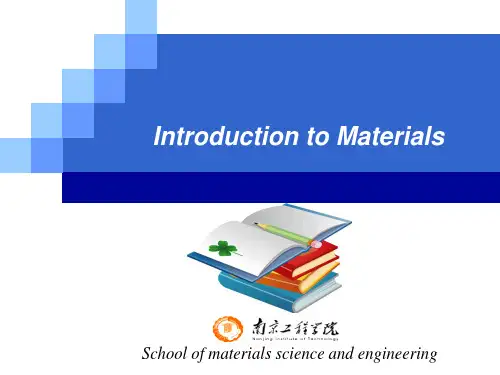


材料科学与工程导论(双语)Chater_8INTRODUCTION TO MATERIALSSCIENCE AND ENGINEERING国家级双语教学示范课程ISSUES TO ADDRESSCHAPTER 9BIOMATERIALS/NANOMATERIALS/SMART MATERIALS What are biomaterials What is nano What are smart materials Applications of smart materialsAn Interdisciplinary FieldBioengineersMaterial ScientistsImmunologistsChemistsBiologistsSurgeons.9.1 BiomaterialsA Little History on BiomaterialsRomans, Chinese, and Aztecs used gold indentistry over 2000 years ago, Cu not good Ivory & wood teethAsepticsurgery 1860 ListerBone plates 1900, joints 1930Turn of the century, synthetic plastics came intouseWWII, shards of PMMA unintentionally gotlodged into eyes of aviatorsParachute cloth used for vascular prosthesis1960- Polyethylene and stainless steel beingused for hip implantsWhat’s a biomaterial?1980 - Passive and inert point of viewAny substance or drugs, of synthetic or naturalorigin, which can be used for any period aloneor as part of a system and that increases orreplaces any tissue, organ or function of thebody.1990 ? Active point of viewNon-living material used in a medical deviceand designed to interact with biologicalsystems.Classification of BiomaterialsFirst generation: INERT Do not trigger any reaction in the host: neitherrejected nor recognition “ do not bring anygood result”Second generation: BIOACTIVE Ensure a more stable performance in a longtime or for the period you wantThird generation: BIODEGRADABLE It can be chemically degraded or decomposedby natural effectors weather, soil bacteria,plants, animalsMean Features for Medical ApplicationsBIOFUNCTIONALITY Playing a specific function in physical andmechanical termsBIOCOMPATIBILITY Concept that refers to a set of properties that amaterial must have to be used safely in abiological organism The ability of a material to perform with an appropriate host response in a specificapplication Host response: the reaction of a living system to the presence of a material.What is a biocompatible material?1 Synthetic or natural material used in intimatecontact with living tissue it can be implanted,partially implanted or totally external.2 Biocompatible materials are intended tointerface with biological system to EVALUATE,TREAT, AUGMENT or REPLACE any tissue,organ or function of the body A biocompatible device must be fabricated frommaterials that will not elicit an adverse biologicalresponse.Biocompatible material features1 Absence of carcinogenicity 致癌性 the abilityor tendency to produce cancer2 Absence of immunogenicity 致免疫性absence of a recognition of an external factorwhich could create rejection3 Absence of teratogenicity 致畸性 ability tocause birth defects4 Absence of toxicityWhat’s a bi odegradable implant Once implanted, should maintain its mechanical properties until it is no longerneeded and then be absorbed and excretedby the body, leaving no trace Biodegradable implants are designed to overcome the disadvantages of permanentmetal-based devices.BiomaterialsPolymeric biomaterialsBioceramicsMetallic biomaterialsBiocompositeBiologically based derived biomaterials Polymeric Biomaterials: Adv. & Disadv.聚甲基丙烯酸甲酯,俗称“有机玻璃”。
材料科学导论(双语)教学大纲《材料科学导论》(双语)教学大纲一、课程基本信息课程编号: 0421170材料科学导论(双语)课程中文名称:Fundamentals of Materials Science and Engineering课程英文名称: 专业课课程类别:材料物理专业、材料化学专业、无机非金属材料专业、金属适用专业:材料专业、高分子材料与工程专业4开课学期:64学时总学时:4总学分:大学英语(1011021)、基础化学原理(0211011)、大学物理预修课程(编号): (0621020)、高分子化学与物理(0421230) 并修课程(编号): 材料科学基础(0421080)、材料热处理(0421030)、复合材料(0411080)本课程是我校为材料类宽专业本科学生开设的专业课程。
课课程简介:程凝聚材料学科知识和应用型英语知识的精髓,使用英文原版专业教材,通过中英双语授课工程材料技术,材料家族,材料组成、结构、性质、表征、分类、加工与再生利用,以及材料选择的基本概念和基础理论,结合上述专业知识讲授相关的专业英语语言知识,并讲授英语学术演讲和英语科技论文写作基础知识和要点。
建议教材: Fundamentals of Materials Science and Engineering, William thD. Callister Jr., 5 Edition, John Wiley & Sons, Inc., 2001[1] The coming of materials science, R. W. Cahn, Pergamon 参考书:Press 2001[2]《材料科学导论》,冯端,师昌绪,刘治国等编,化学工业出版社,2002年5月第1版[3]《材料科学与工程基础》,顾宜主编,化学工业出版社,2002年4月第1版二、课程教育目标本课程的教育目标是培养创新性、研究型、国际化的一流人才。